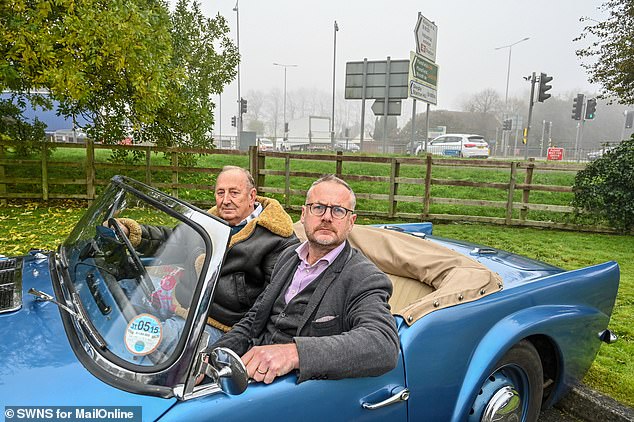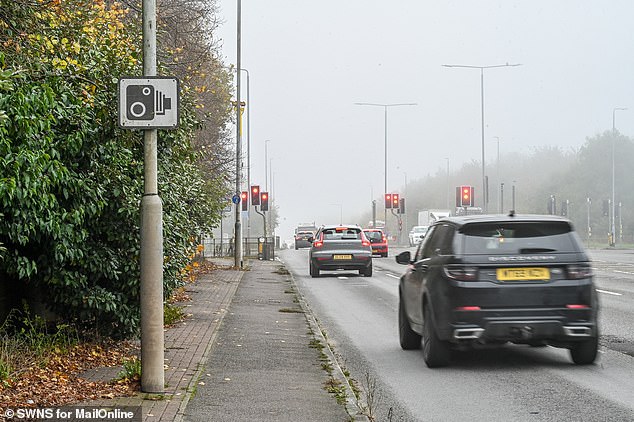Do you live near one of Britain’s most annoying speed cameras? These are the 20 most productive speed traps
Motorist Brian Staples drives extra carefully as he approaches the stretch of road with Britain’s most prolific speed camera.
In just eight months, this money-cuckoo has already trapped 17,498 victims – more than 70 motorists a day – and nets the government millions of pounds. He doesn’t want to join their ranks.
But even Brian, who gives me a lift in his 1961 Daimler Dart and knows the road well, is almost caught off guard by this confusing and busy junction on the A38 in Sutton-in-Ashfield, Nottinghamshire.
There are more than 7,000 speed cameras on our road network, meaning millions of motorists are caught using various traps every year
He said: ‘This is a sneaky speed trap, misleading motorists who have already been fooled by the maze of road signs and traffic lights at this intersection.
‘Nobody is against traffic calming measures that help save lives, but this annoying box is just a money machine.’
As organizer of the 2,000-strong Griffins Head Classic Car Club, a local group of car enthusiasts who want to share their enthusiasm for driving, he points out how this busy intersection is designed to snare motorists. It’s hard to disagree.
No fewer than 22 separate traffic lights have been placed around it. As you drive towards the camera on this dual carriageway, there is a speed limit of 120 km/h that suddenly changes to 80 km/h – complete with a speed camera above your head.
But then, about 100 meters from the intersection, it inexplicably goes to 50 km/h. Although signposted, it is one of six other road signs at this traffic light jungle.
There are more than 7,000 speed cameras on our road network, meaning millions of motorists are caught using various traps every year. The first and most common is the Gatso, introduced in 1991.
These rear-facing cameras emit a radar signal to monitor movement and take two photos (a double flash) to record speed and registration. There should also be white lines on the road to confirm speed.
The Truvelo is another popular camera, but this one is forward-facing. It was introduced to capture an image of the motorist and prevent drivers from using the excuse that they are not behind the wheel.
It does not flash, but uses infrared technology to record motorists. There are four sensors hidden in the road surface that calculate the speed, with three white lines painted across the road. Mobile speed cameras mounted outside or in parked vans are another enemy and can capture you from up to a mile away.

On the road: Reporter Toby Walne gets a ride with motorist Brian Staples in his 1961 Daimler Dart
But when we get out of the car with Brian to examine this particular camera, we discover that it is a Vector SR: the latest high-tech speed trap weapon. It uses an ‘intelligent virtual grid’ within the yellow box that calculates speeds using a computer program.
Thanks to infrared light for illumination, it can capture you secretly without a flash – and it works just as well at night and in bad weather.
The high-definition camera can also read your car’s license plate and the Vector SR has the technology to check whether you are wearing a seat belt, using a phone behind the wheel or making an illegal turn. It is believed that nationwide speed cameras rake in £1 billion annually.
Legal Expert, a personal injury, compensation and accident lawyer, has put together the most up-to-date information map of the worst speed cameras in Britain – with this yellow box in Nottinghamshire being the best.
Legal experts have submitted a freedom of information request to all 43 police forces in England and Wales, asking about the number of speeding fines issued. Only 23 responded.
But they revealed that more than 5.2 million speeding tickets were issued during the 12 months ending April 5. If we add the authorities who did not respond, an estimated nine million were distributed.
This does not include statistics for Scotland and Northern Ireland.
The minimum fine is €100 plus three penalty points on your driving license – unless you can take a road awareness course.
But for the most serious speeding offences, such as speeding over 100mph on the road, you can be fined up to £1,000 – £2,500 on the motorway – and your driving license will be revoked.
Retired electronics engineer Brian, 76, says: ‘I think if you get caught on camera you should get a warning in the post first. If you are caught again, you will be fined.

Cash machine: The A38 speed camera has captured 17,498 victims in just eight months – more than 70 motorists a day – and rakes in millions of pounds for the government
And cameras need to be more clearly marked to ensure you stick to the limit. Hiding them or installing confusing signage only makes you less safe as a driver.’
Back at Brian’s Daimler Dart, after passing this speed camera on our left, we navigate the junction with the traffic lights and cross, heading towards Mansfield, four miles to the north-east.
This particular camera was installed after two fatal traffic accidents near the intersection.
Brian believes that this is a commendable reason for the camera, but it can also be treated like a cash cow.
The money from speed camera fines goes into a Consolidated Fund, the government’s bank account at the Bank of England. It is then used for spending, with the Department of Transport distributing much of it through grants.
Since 2000, local governments have also been able to keep some of the money raised by speed cameras to fund regional projects.
Nicholas Lyes, director of policy and standards for automotive group Institute of Advanced Motorists (IAM) RoadSmart, said: ‘There is a misconception that these cameras are cash cows for the police, but the money usually goes to the government and local councils.
‘Being caught speeding can be a costly inconvenience, but it can also be a matter of life and death. It’s important to find a balance and always watch your speed.’

Hit the brakes: as you drive along the dual carriageway towards the camera, there is a speed limit of 110 km/h which suddenly changes to 80 km/h and then inexplicably only reaches 50 km/h.
Simon Williams, from the RAC, said: ‘Frighteningly enough, eight in 10 admit to speeding. Most see the speed limit as a goal rather than something you shouldn’t break.’
Ignorance is no excuse, and the rules are in the Highway Code. On motorways and dual carriageways there is a speed limit of 120 km/h, on single carriageways the speed limit is 100 km/h and on urban roads with street lights it is 48 km/h – or 30 km/h in Wales and city centers such as Bristol and Manchester , and much of London.
A speed camera is usually set with a leeway of 10 percent plus 2 km/h, so it may happen that you are driving at 55 km/h in a 50 km/h zone, but you cannot guarantee this.
Penalties for speeding are grouped in severity from A to F. Band A is for speeding up to 10 miles per hour over the limit and will get you three points and a fine of up to 75 percent of weekly income.
Those caught speeding up to 10mph over the limit should be able to opt for a day’s speed awareness course instead of points and penalties – which for £100 is a better deal.
Band B applies up to 30 km/h above the limit and carries a fine of up to 125 percent of the weekly salary and six points, while band C applies to speeds above this level and carries fines of up to 175 percent of the weekly income and six points. .
Penalty points remain on your driver’s license for four years. You may receive a driving disqualification of one or two months instead of points for bands B and C, while bands D to F involve aggravating factors such as driving while banned – which could earn you a fine can receive up to 700 percent of weekly driving bans. income and see your driver’s license revoked.
If you accumulate 12 points within three years, your driver’s license will be suspended for six months.
The RAC says the 1,645 road deaths last year would have been much higher if it weren’t for these cameras.
The government believes that 20 percent of deaths are related to ‘exceeding the speed limit’, so the traps could have saved more than 300 lives.
How to appeal a speeding fine
Only one percent of speeding fines are appealed, with about half of these appeals being successful. You must have proof. The best challenges involve technical details.
- If you receive a speeding fine, you will receive a Notice of Intended Prosecution (NIP) by post. If it contains the wrong information, such as time, date, location or speed, you may be able to challenge the case.
- Even if you were not the driver, you can object to a fine. You must provide details of the person behind the wheel by completing a ‘Section 172 notice’.
- If speed limit signs are incorrect, broken, hidden or missing, take photos of them.
- If the speed measuring equipment is not properly calibrated, you may have a problem. Unfortunately, the only way you can prove this is to take it to court. The police do not have to hand over this evidence in advance.
- You must plead ‘not guilty’ within 28 days of the Notice of Intended Prosecution.
You can represent yourself, but it is often wise to seek help. Debt support website MoneyNerd recommends contacting an online lawyer service such as JustAnswer.
Some links in this article may be affiliate links. If you click on it, we may earn a small commission. That helps us fund This Is Money and keep it free to use. We do not write articles to promote products. We do not allow a commercial relationship to compromise our editorial independence.
